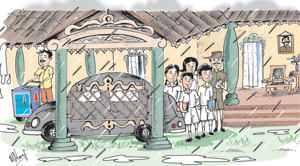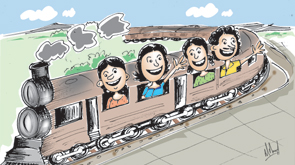
The lost porticoOdd, the memories that linger, long after a place is gone…. Driving through the city as the rain pelts down, my heart bleeds for the pedestrians scurrying desperately for a roof to shelter beneath. The only spots available to them are ramshackle bus halts, skimpy overhangs in front of shop windows or the imposing entrances to up-market shopping malls flanked by glowering security guards. Here they cluster in damp proximity, like bees outside a hive, till the rain ceases and they can escape their unwelcoming shelters. Private residences in the city now lurk unseen behind high walls and locked gates. The streets of boyhood memory were far friendlier places for pedestrians escaping monsoon downpours. Boutiques had roomy verandahs abutting the pavement and little tea-shops allowed these uninvited ‘guests’ to cluster at their entrance where the tea-maker clanged by his steaming brass samovar. Nobody was ever shooed off. What we loved most, however, was when the rain caught us as we walked past quiet suburban lanes with homes fronted by hospitable porticoes, never seen today except in period teledramas. The portico was a standard architectural feature of a middle-class home. It was roomy enough to shelter a large car or a buggy-cart and bull. Two or three steps, flanked by potted palms, led up to the verandah proper, furnished with a few cane chairs clustered around a ‘tea-poy’ decorated with a brass Kandyan bowl perched on three kneeling elephants. A glass panelled door and lace curtains screened the living room. A little room on the side served either as a ‘Budu-ge’, the husband’s office-room or as a refuge for an old bachelor ‘uncle’.
The portico fulfilled a function essential to a way of life, now long gone. It served as a sort of ‘anteroom’ where the lady of the house could interact with those who could, or would, not step indoors. Seated on a verandah chair, she bargained with vegetable basket women, fish vendors and Chinese silk traders, dispensed largesse to beggars and screened peasants from the gama seeking favours. When rain clouds burst, we pedestrians pushed open the low, wooden garden gate and rushed to seek refuge beneath the nearest portico. No amount of maternal arm-twisting could ever make a schoolboy carry an umbrella. This was the trademark of monks, iskola- and veda-mahattayas. There was a cheery camaraderie among those sheltering under the portico. We were a microcosm of the society of that time – schoolboys, timid schoolgirls, ice-cream vendors, clerks, pingo-carriers, cobblers, postmen, bottle-collectors and oil-vendors. If the rain persisted, a little ‘Banda’ would emerge from the hall and invite those of us ‘respectable-looking’ enough, to sit on a verandah chair, where we perched uneasily and kept peering out at the sheets of rain hoping for a break in the clouds when we could make a run for it. We never bothered to express our gratitude. Sheltering under other people’s porticoes was just the norm in that companionable era abundant in welcoming porticoes, so distant from the high-rises, gated communities, wall-hidden mansions and flashy super-malls of today’s conspicuously consumerist age. May this brief memento serve as a requiem to the wonderful, hospitable portico, long buried beneath the twin cravings for modernity and exclusivity. The Thambi-kaday Whenever I stop by the little shop at the top of our lane I am amazed at the variety of stuff on sale. But every single item is "cribbed, cabinned and confined" in sili-sili packets, little cartons or sachets. No provisions are ever seen, or smelt, in unadorned splendour. How different were things, way back during my boyhood in the 1940s. Not far from our home on Kandy’s ‘Horseshoe’ Street, at its junction with Castle Street, was our thambi-kaday, an honest description devoid of ethnic overtones. It was typical of the hundreds of such kadays in nooks and corners of every town in Ceylon. I was a fairly regular customer, not in my own right but as an errand boy from home, to buy a few cigarettes for Father or Jaffna cheroots for Seeya. The interior of the kaday was separated from the pavement by a long wooden counter with a flap-top on a side which gave it access. It was a strictly one-man-show run by a cheery grey-stubbled Thamby, hemmed on two sides by waist-high open-topped wooden trays, each containing a different commodity essential for the kitchen – onions, potatoes, ginger, dried fish, goraka, sooduru, maaduru – all tickling our noses with spicy scents. These commodities were weighed out on a swinging scale and wrapped in paper cones for the buyer. Frequently this wrapping paper came from old school exercise books with scraps of sums and intriguing compositions. At the back of the kaday there was a barrel of coconut oil which was drawn from it with a little tin welded to a longish stiff wire and poured through a small funnel into the buyer’s bottle. The loose cigarettes I came for, were extracted from a tin kept in a drawer and duly wrapped in paper to keep them dry till I went the few yards home. Inky-black Jaffna cheroots, in damp bundles, were displayed in large-mouthed glass bottles on the front counter, alongside a similar display of slim little beedies. Coolies (to use the designation then current), and rickshaw-pullers lit their beedies and cheroots from the smouldering length of thick rope that swung from the eaves. The counter was a magnet for all of us children. Wide-mouthed glass bottles held a colourful and tantalizing array of sweets. There were rough lumps of sookiri (cane sugar), multi-coloured pellets of sweet mee-beti (rat drops) with a sooduru grain at their centre, delightfully acid naarang bik (mandarin slices), orange and yellow and slathered in icing sugar, pepperminty bulls eyes striped in black and white and occasionally, alpay (incredibly sweet and soft stubby sugar candy sticks, a closely guarded recipe of the legendary Mrs. Sproule of Sproule’s Bakery). Such kadays have long since fallen to the onslaught of multinationals and their globalized brands, of which the corner shopowners of today are but mere salesmen. Train journeys Whenever I am held up at a railway crossing and see the unfortunate passengers clinging precariously to footboards and overflowing from windows I recall the more spacious days at Dharmaraja’s junior school where we learnt that Ceylon, London and Australia had the same population of six million. It was no wonder that trains were never crowded and our family, of four children and two adults, never had any difficulty in finding a compartment (Third Class) all to ourselves all the way from Kandy to Colombo. The four of us did not have to squabble for seats as each had his, or her, own corner from which we watched the world go by. Unseen by disapproving parents we competed in pelting banana skins at village boys gawking as the train roared past. We rarely scored a hit, being unaware of the laws of physics that governed the trajectory of flying objects from speeding trains.
Rambukkana station and its vadais were the other highpoint of our journey. Every window was invaded by Tamil women shouting out their piping wares, finger sculpted round a generous sliver of umbalakada. My taste buds yet tingle at their memory, and my nostrils yet remember the coal dust we inhaled. The wheels of change brought us to school in Ratnapura and a home in Tiriwanaketiya, a few miles away. We were now along the KV Line with its slow narrow-gauge trains. They faced unique problems such as wheels given to slippage on wet rubber leaves when ‘wintering’ trees dropped their leaves. The family had a ‘reserved’ buggy cart to travel to school. As it could not find room for my long legs I had to travel by train – which was good fun. Third Class train fare was 10 cents and I whiled away my time at the little spick-and-span station watching the Station Master (SM) and his minions executing the Victorian rituals of railway culture. The train to town was never crowded and I usually joined the compartment already holding my schoolmates from Dela and Opanaike. As I became more observant, I noticed that the Second Class compartment carried quite a few nice-looking girls in school uniforms headed for the Convent or Ferguson School. The possibility of striking up an acquaintance excited my adolescent imagination. Second Class fare was 15 cents, which I could just afford. I now bought a Second Class ticket from a puzzled SM and hopefully boarded the girl-carrying compartment. I found myself the sole boy amidst a gaggle of girls who carried on chattering, ignoring my presence. My hopes of a cosy tete-a-tete bit the dust, as I slunk out of the girls’ compartment. It was back to the Third Class for me. I now joined a school in Colombo while the family remained in Tiriwanaketiya. Holidays brought me home on the KV train which, incredibly, took five hours to travel 60-odd miles. I did not mind, I was in no hurry and equipped with a load of novels. As we were now entitled to Second Class holiday warrants, I travelled in solitary grandeur, as anybody in a hurry went by bus in a couple of hours. Meanwhile, the train chugged along in leisurely style picking up short distance passengers and stopping at every little station. Once in a while the train made an ‘unscheduled’ stop at an estate beef stall where the Driver and Guard replenished their larder. The time-table was just a fiction. School holiday season was on and the daughters of SMs, released from city schools, were having great fun. Their homes were the top floor of the two-storey station and, usually, embowered in flowering honeysuckle or Thunbergia. They hung over the balustrades whenever a train chugged in, waving vigorously when it chugged out or, daringly, sending flying kisses to young men at carriage windows. Those golden lasses are now but a blip in the memory, the railway stations they once adorned are now abandoned and forlorn – and the KV line no longer runs to Ratnapura and beyond. ‘So sad, so fresh, the days that are no more.’ |
|| Front
Page | News | Editorial | Columns | Sports | Plus | Financial
Times | International | Mirror | TV
Times | Funday
Times || |
| |
Reproduction of articles permitted when used without any alterations to contents and the source. |
© Copyright
2008 | Wijeya
Newspapers Ltd.Colombo. Sri Lanka. All Rights Reserved. |

